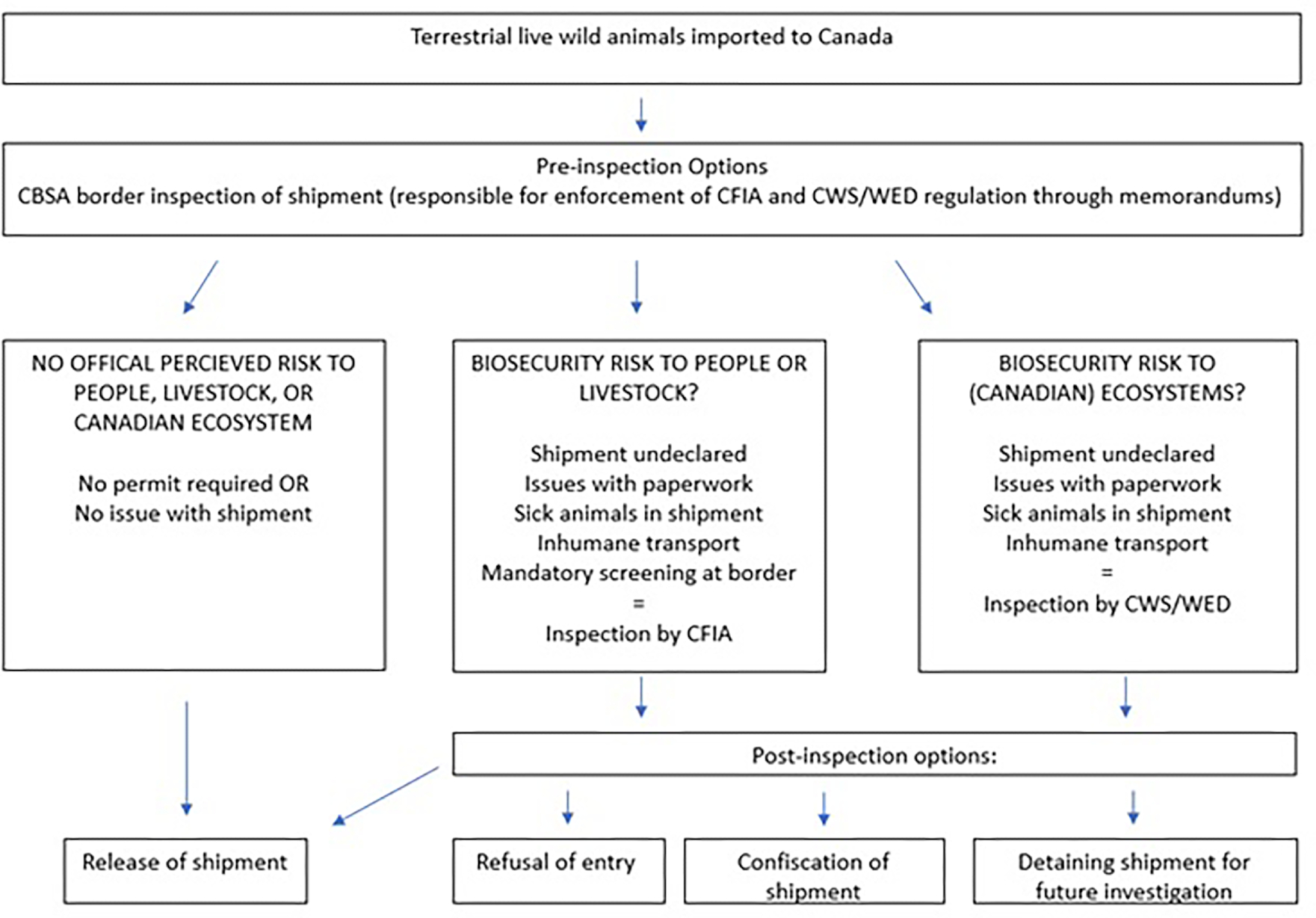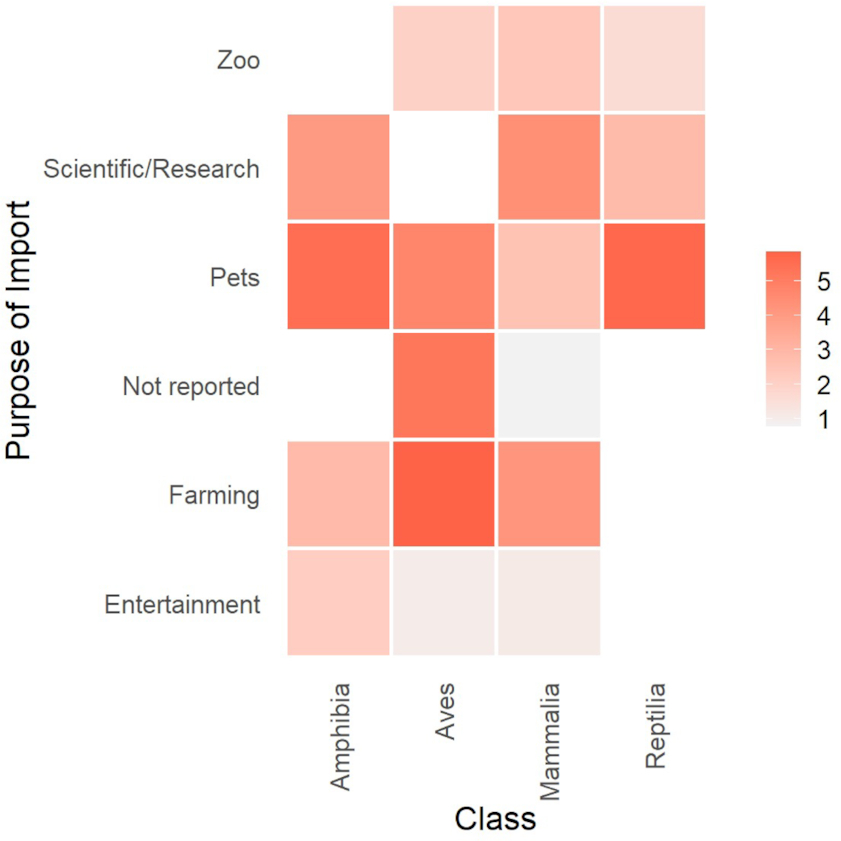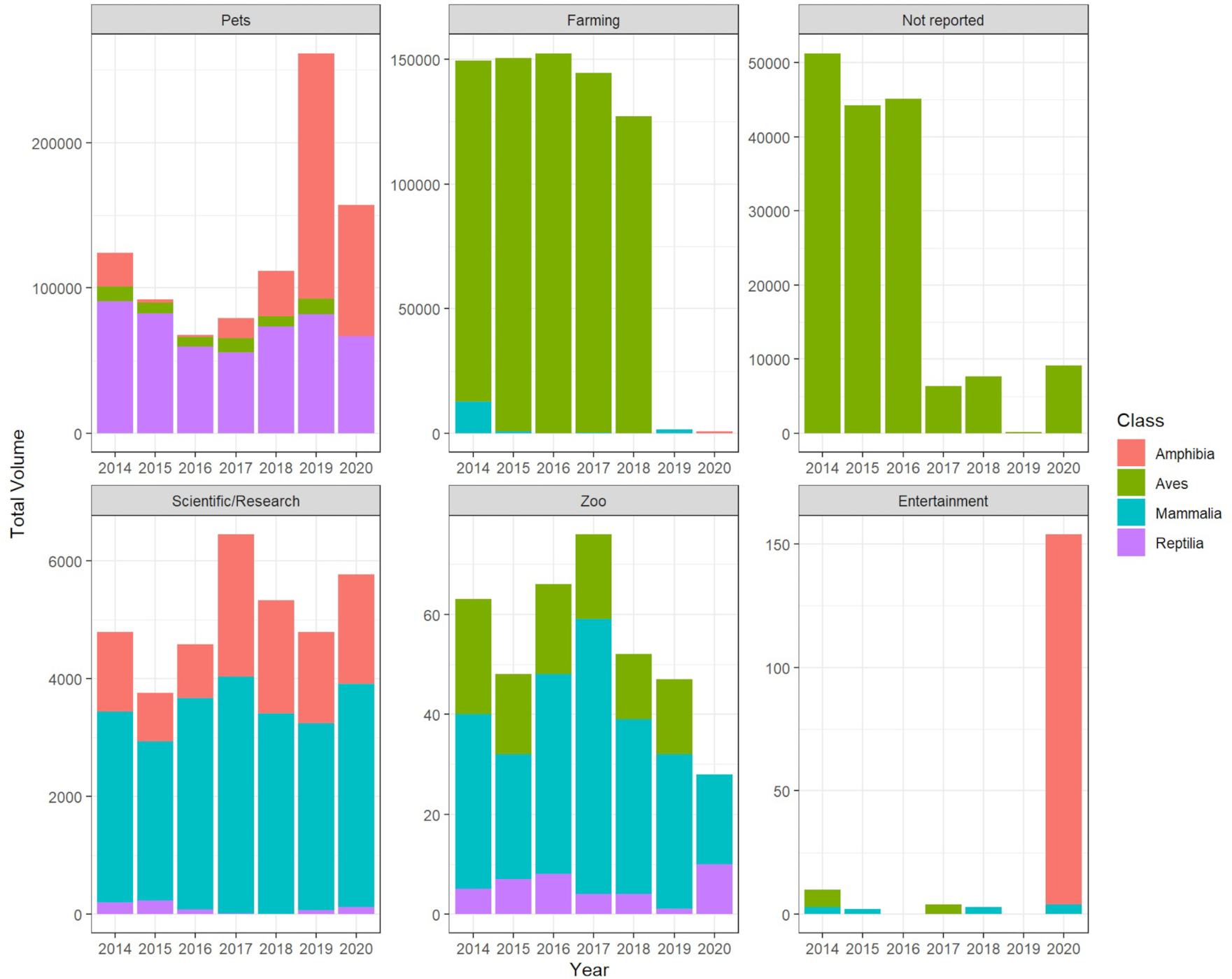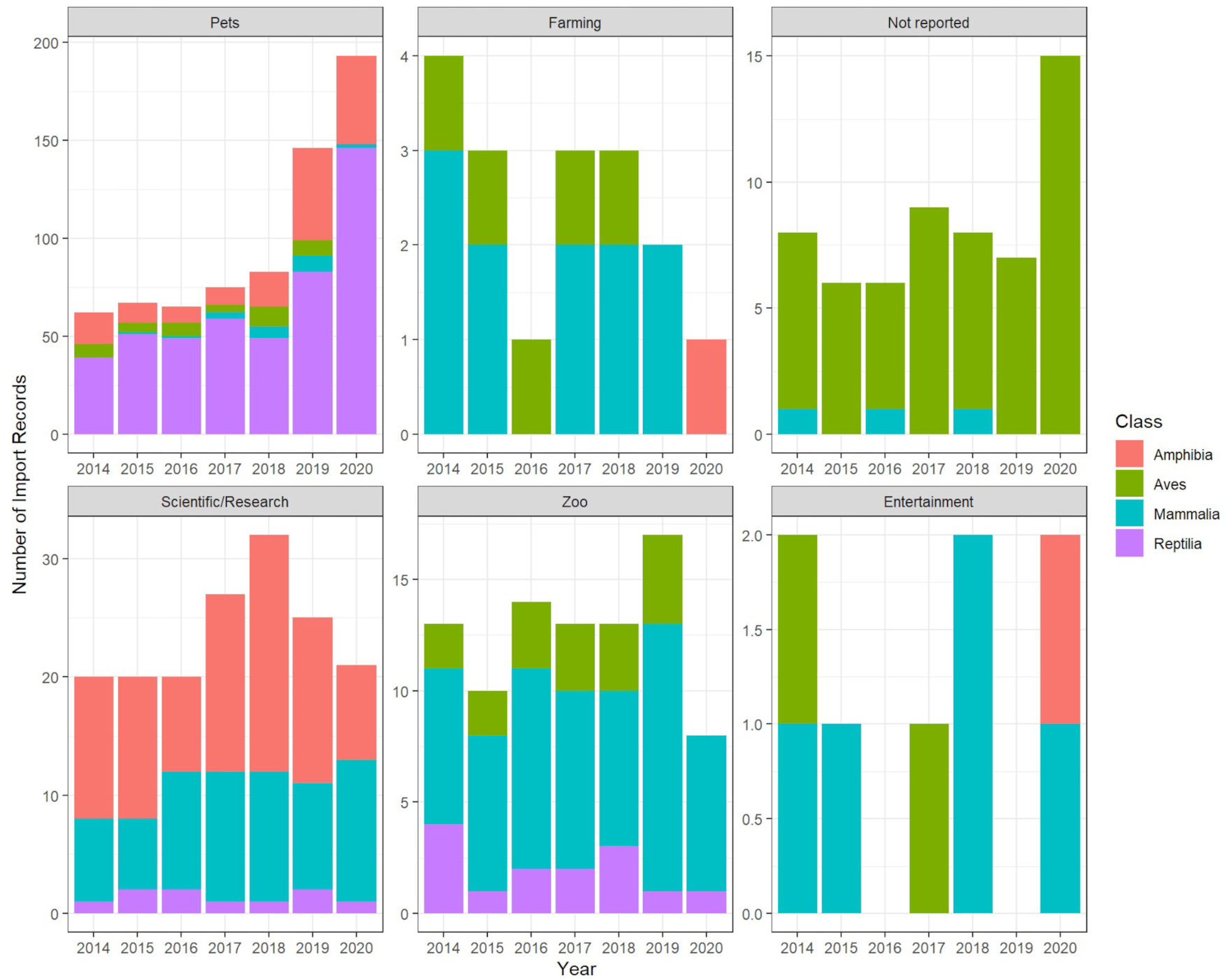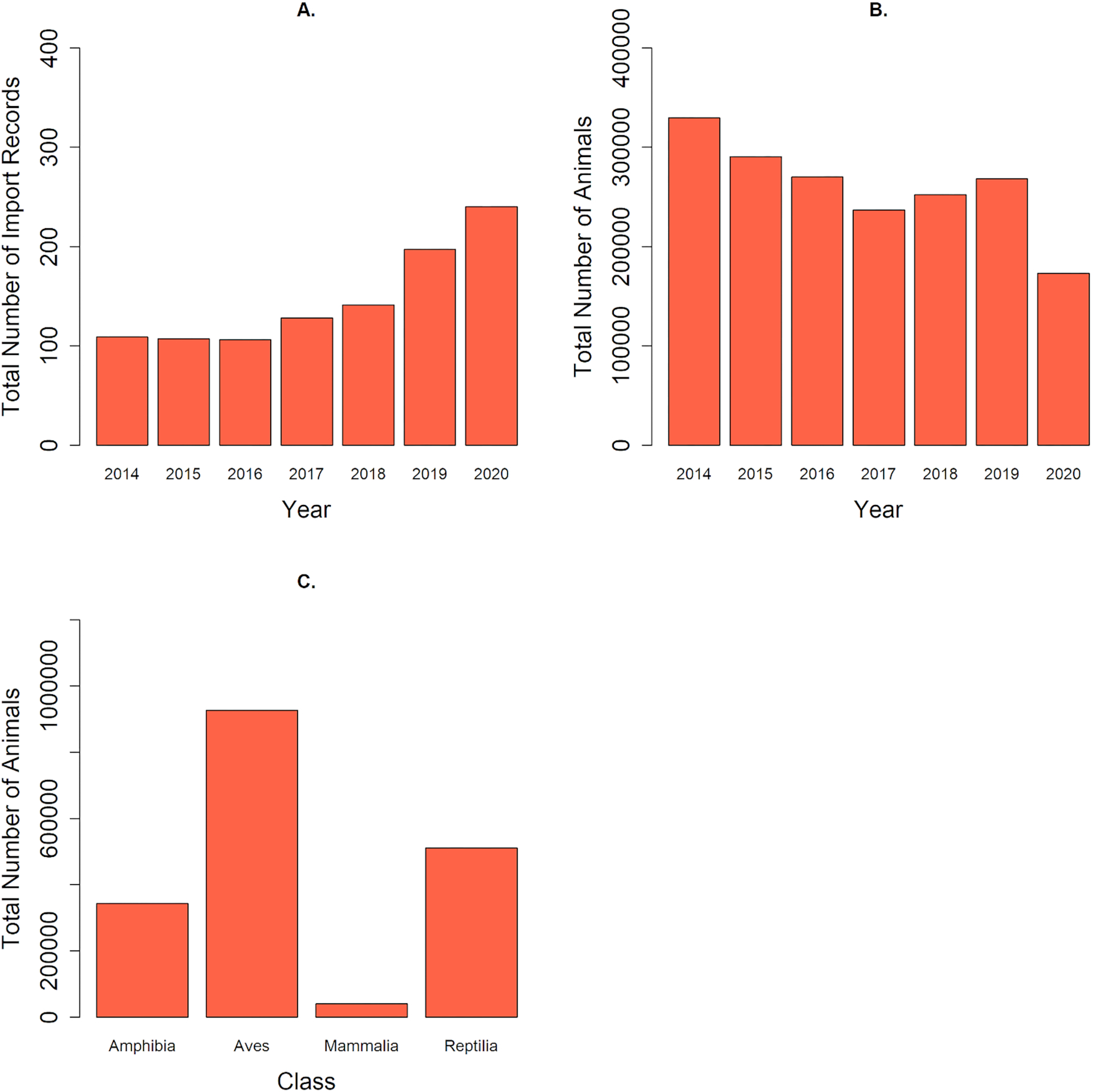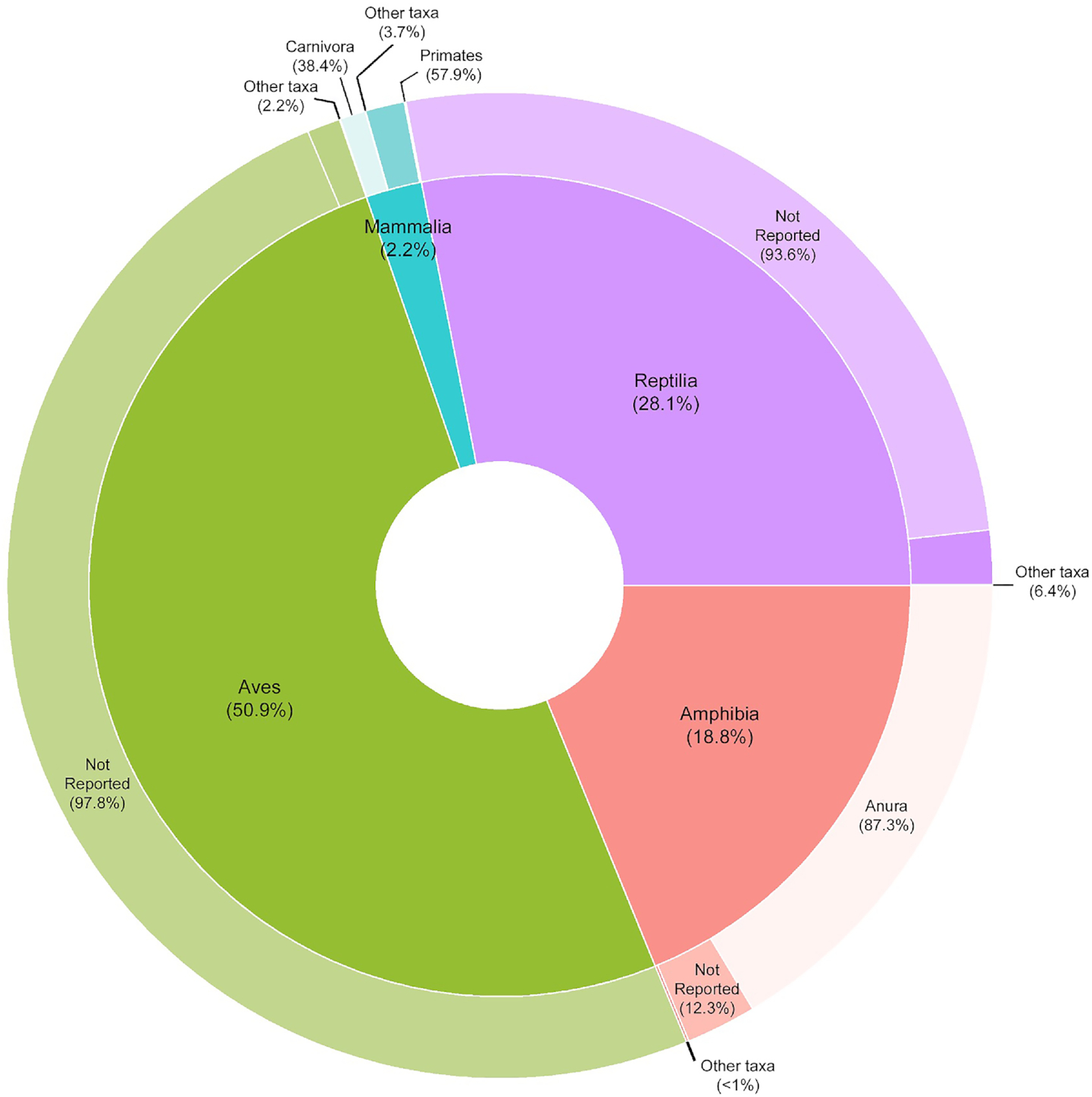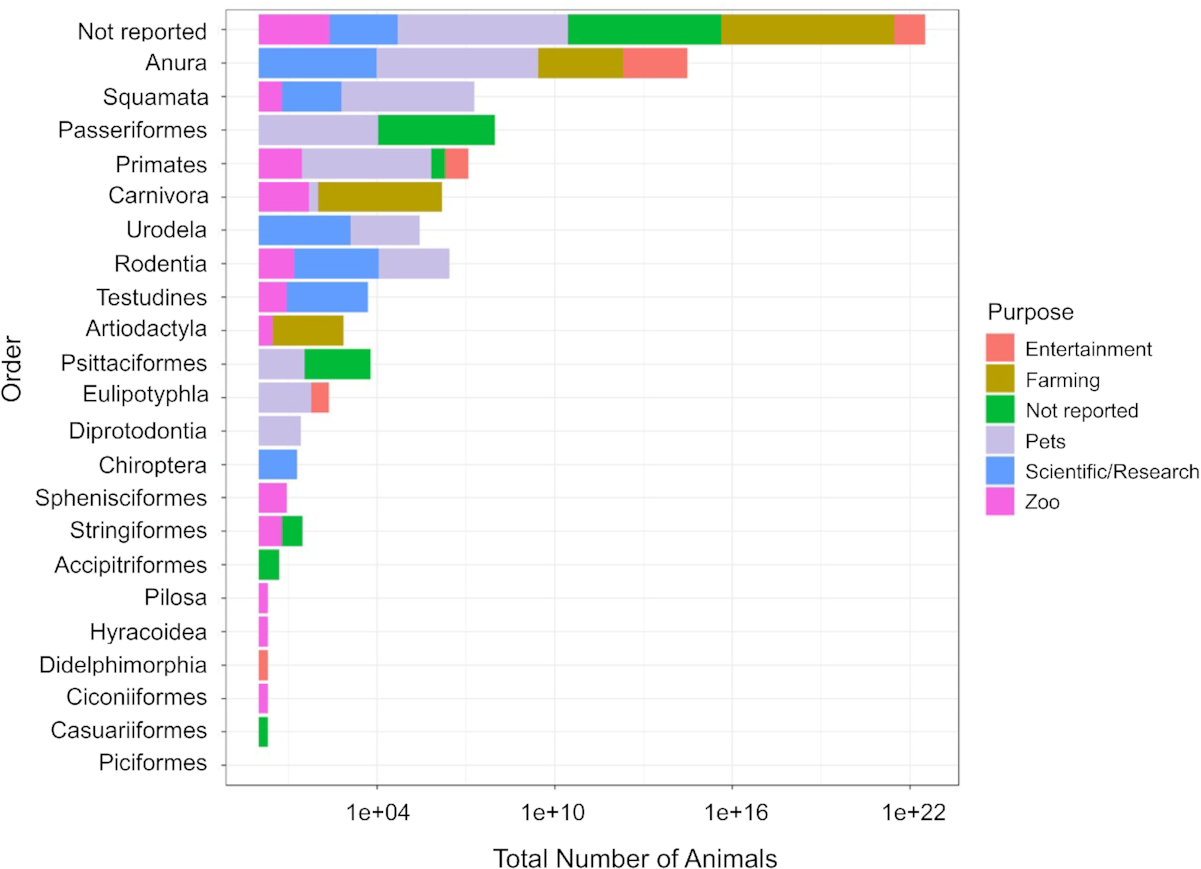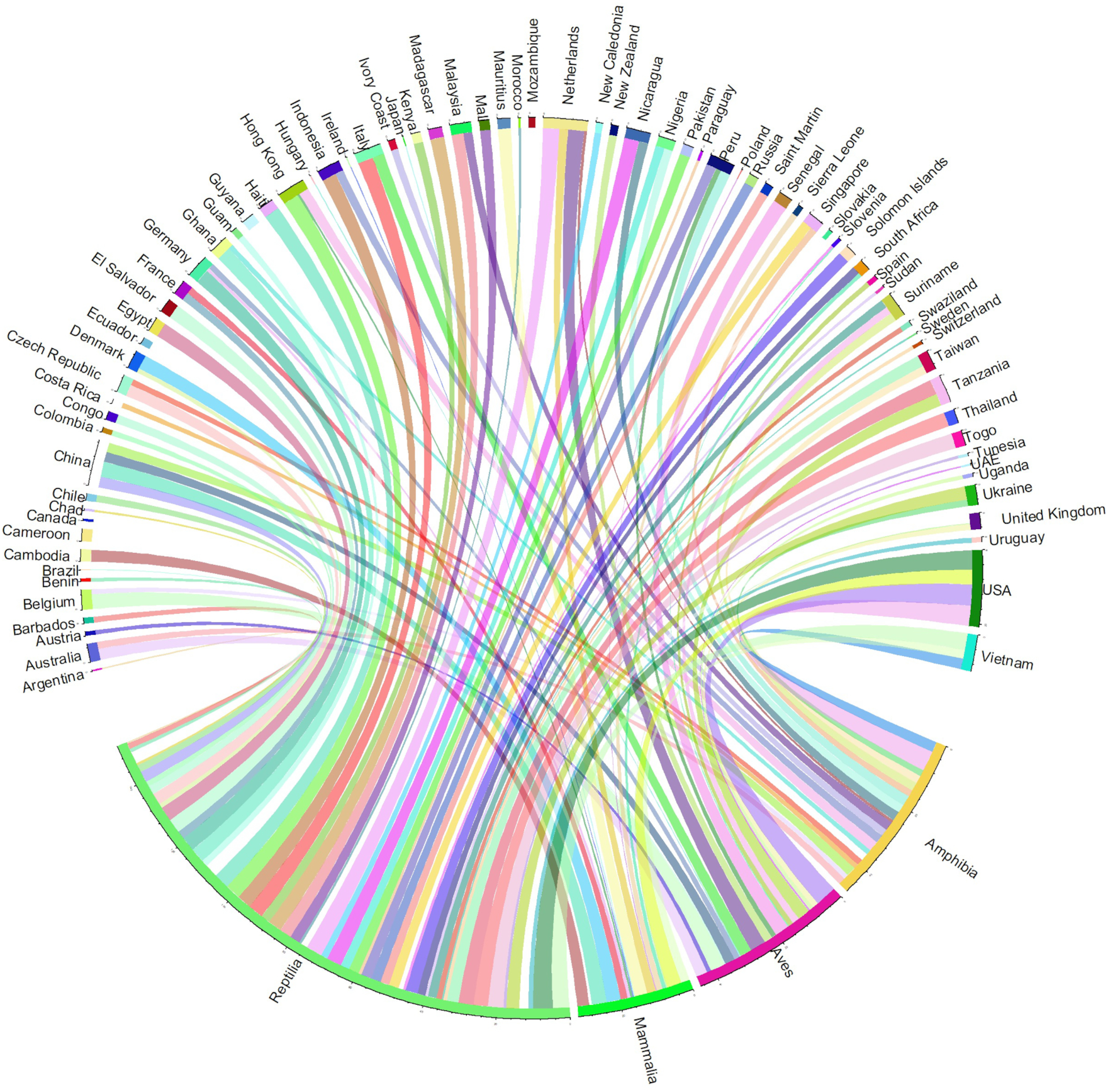Introduction
The global wildlife trade is a multibillion-dollar industry that involves around a quarter of Earth's terrestrial vertebrate species (
Scheffers et al. 2019). The trade can have positive outcomes by providing potential socioeconomic benefits for local communities (
Roe and Lee 2021). However, the relation between the trade in wild animals and potential positive outcomes is often ambiguous (
Challender et al. 2022) and it is difficult, expensive, and labour intensive to gather data to determine whether the trade, or aspects of it, has positive, neutral, or negative outcomes (
Frank and Wilcove 2019;
Marshall et al. 2020;
Hughes et al. 2021). The negative outcomes of wildlife trade are more clearly established. The commercial trade in wild animals for exotic pets, luxury goods, entertainment, meat, and traditional medicine represents one of the most prominent direct drivers of biodiversity loss (
Morton et al. 2021) and species extinction risk globally (
Díaz et al. 2019). Wildlife trade also indirectly places pressure on biodiversity through the spread of pathogens (
Springborn et al. 2015;
O'Hanlon et al. 2018) and invasive species (
Reino et al. 2017;
Cardador et al. 2019;
Lockwood et al. 2019) and can be harmful to the health and welfare of the individual animals involved (
Baker et al. 2013). Human health is also threatened, as the trade in wild animals and their parts can, depending on the species, carry a high potential for zoonotic disease emergence and transmission (
Smith et al. 2009;
IPBES 2020). The COVID-19 pandemic, for example, which has been linked to the trade in wildlife (
Boni et al. 2020), has resulted in unparalleled global social and economic damage, causing more than five million human deaths worldwide (
WHO Coronavirus (COVID-19) Dashboard 2022) and an estimated cost of US$1 trillion to the global economy in 2020 alone (
UNCTAD 2020). The emergence, impact, and severity of zoonotic diseases depend on a range of factors including the species involved and the prevalence of human activities (
Borsky et al. 2020).
The wildlife trade is the movement of live wild animals (i.e., undomesticated animals, both wild-caught and captive-bred) and plants, and parts thereof (
Broad et al. 2002), for commercial purposes, including as pets, food, entertainment, traditional medicine, and luxury goods like fashion and trophies (
Smith et al. 2017). The trade includes wild animals that are captive-bred, reared, ranched, or taken from the wild (
Nijman et al. 2018;
Harrington et al. 2020) and is composed of both legal and illegal markets (
‘t Sas-Rolfes et al. 2019). Legality of the trade is complex, in many cases varying by jurisdiction, so animals’ status as legal or illegal can shift as they are moved through the supply chain (
Wyatt et al. 2020). In recent decades, globalization, ease of and access to travel, and increasing wealth and wealth inequality have led to intensified commercialization of the wildlife trade (
Liew et al. 2021;
Wu 2021). Moreover, the rise of social media (
Martin et al. 2018;
Moloney et al. 2021;
Stringham et al. 2021) has led to an expansion in the reach and number of connections in wildlife trade networks, complicating enforcement efforts and exacerbating the risks posed.
Previous studies and calls to action related to wildlife trade have largely been unbalanced in their geographic focus, with much more work focused on biodiversity hotspots, such as Southeast Asia and Africa (
Can et al. 2019;
United Nations Office on Drugs and Crime 2021) where the effects of the wildlife trade are most publicized, or in regions where demand for wildlife products is seemingly the greatest, for instance in the United States of America (US), Europe, and China (
Auliya et al. 2016;
Symes et al. 2018;
Xiao et al. 2021). However, other countries, like Canada, also play a role in the commercial wildlife trade. Specifically, Canada has been identified as one of the largest (re)exporters of Convention on International Trade in Endangered Species of Wild Fauna and Flora (CITES)-listed species that are carriers of at least one zoonotic disease (
UNEP-WCMC and JNCC 2021). Canada also plays a role as an intermediary, for example in relation to trade in marine aquarium animals and live hoofstock to the US (
Rhyne et al. 2017;
Smith et al. 2017), the legal and illegal trade of bear parts to countries such as the Czech Republic (
Shepherd et al. 2020), Australia, and New Zealand (
Cassey et al. 2021), and the trade in ball pythons (
Python regius) as exotic pets from West Africa (
D'Cruze et al. 2020c). The overall average annual financial value of the legal live wild animal trade in Canada from 2016 to 2020 was estimated at $85.7 million CAD for exportations and $100.6 million CAD for importations (
Government of Canada 2022). For wild animal parts and derivates (excluding species used in aquaculture), the estimated value averaged $33.1 million CAD for exportation and $39.1 million CAD for importation during the same 5-year period (
Government of Canada 2022).
Aside from these existing studies and data, little is known about the volume and species of live wildlife imported into Canada, leaving the overall trade inadequately qualified and quantified. In this paper, we develop an initial detailed picture of the volume and type of live wildlife species imported into Canada to fill this knowledge gap. To achieve depth in our analysis, we have a relatively narrow focus on the importation of live wild vertebrate animals. For the purposes of this study, we define wild animals as undomesticated animals, both wild-caught and captive-bred. Although the line between wild and domesticated animals is not clearcut (see
Braverman 2015), our definition follows other studies of wildlife trade, as well as CITES, which include captive-bred and reared animals as wildlife (e.g.,
Bush et al. 2014;
Smith et al. 2017). Our study includes mammals, birds, reptiles, and amphibians, imported for purposes such as pets, farming, zoos, scientific research, and entertainment. All other taxonomic classes are excluded, including all invertebrates, fish, and plants. Fish were excluded because the high volume of their trade would have likely significantly skewed the dataset, and because Canada's regulatory measures around fish importations largely focus on preventing disease introductions that could impact native wild fish populations rather than preventing zoonotic diseases. Furthermore, fish also pose a lower zoonotic disease risk (
Ziarati et al. 2022).
In Canada, various ministries and agencies are responsible for the regulation of wild animal importations and exportations, but implementation and enforcement of related legislation falls primarily under the jurisdiction of three main regulatory bodies: the Canada Border Services Agency (CBSA) reporting to the Minister of Public Safety and Emergency Preparedness; the Canadian Wildlife Service (CWS) and the Wildlife Enforcement Directorate (WED) reporting to the Minister of Environment and Climate Change Canada (ECCC); and the Canadian Food Inspection Agency (CFIA) reporting to the Minister of Health and the Minister of Agriculture. The CBSA oversees Canada's international border activities and assists the CFIA, CWS, and WED with enforcement of regulations pertaining to wildlife trade under the Customs Act (importation and exportation) by performing initial compliance verification of shipments guided by operational memorandums (
Government of Canada 2012a,
2012b). The CFIA's mandate is to protect Canada's livestock and mitigate the risk of the introduction or spread of animal diseases through the Health of Animals Act (S.C. 1990, c. 21) and Regulations (
Government of Canada 2015). The CWS is mostly concerned with the policy and permitting implementation of CITES through the Wild Animal and Plant Protection and Regulation of International and Interprovincial Trade Act (S.C. 1992, c. 52) (WAPPRIITA) and Regulations, whereas WED is responsible for the enforcement of the Act and Regulations (
Branch 2017;
Government of Canada 2020)
. Other government departments that may regulate the importation of wild animals include Fisheries and Oceans Canada and Global Affairs Canada.
The CBSA is the gatekeeper, tasked with identifying potential or real noncompliance issues with shipments at the border and subsequently reporting them to the appropriate agency. Any shipment containing live wild animals must be declared at the border. Shipments can be refused entry, confiscated, or detained by the CBSA and referred to the CFIA, CWS, or WED when content is undeclared, when missing necessary permits/certificates, when it is suspected that animals are sick or infected with a reportable or any other disease, or when animals are transported in a “non-humane way and not kept safe from harm and injury” (
Government of Canada 2018;
Minister of Justice 2019) (
Fig. 1).
Over the past two decades there have been calls for increased research into and surveillance of wildlife trade into Canada, to build capacity, and implement preventative measures to address pressing zoonotic disease risks (
Stephen et al. 2004;
Farnese 2014). Some government action has since been taken to mitigate the risk of zoonotic pathogens entering the country. For example, the federal government has restricted commercial live import of high-risk species such as primates, tortoises, and turtles, and a variety of birds and rodents (
Government of Canada 2011a;
Stephen 2019). Additionally, governments have created the Pan-Canadian Approach to Wildlife Health, a collective effort from the federal, provincial, and territorial government departments as well as the Canadian Wildlife Health Cooperative, whose mission is to “strengthen Canada's capacity to identify and reduce wildlife health threats that put conservation, public health, or economic and cultural opportunities at risk” (
Federal, Provincial, and Territorial Governments of Canada 2018). While these actions are important first steps, it remains unclear what data the government is collecting on wildlife importations and how reliable these data are. Comprehensive data are crucial for the government and researchers to conduct meaningful studies, surveillance, and disease risk assessments. Epidemiologists have long argued that any future measures taken to address health risks related to the trade in wild animals must be informed by a comprehensive analysis of data on the import and export of wild animals to and from Canada (
Stephen et al. 2004). However, to our knowledge, with the exception of a peer-reviewed study by Canadian customs concerning the amphibian trade (
Gerson 2012), no such analysis exists.
To begin to address this information deficit, we provide an initial comprehensive analysis of Canadian live wildlife imports, including mammals, birds, reptiles, and amphibians. Data were obtained via Access to Information requests and pertain to Canadian imports, recorded in the CFIA and CBSA databases, of all consignments of live wildlife, i.e., all undomesticated mammals, reptiles, amphibians, birds, and excluding plants, fish, and invertebrates. Domesticated mammals are defined as all livestock, domesticated cats, domesticated dogs, guinea pigs, donkeys, horses, ferrets, rabbits, fancy mice, and fancy rats. We evaluate the type and volume of species entering Canada over a 7‐year period between 2014 and 2020, with additional focus on the country of origin and purpose of import. We requested information on imports between 2014 and 2020 out of processing time considerations and because we wanted to evaluate recent trends in trade. Our aim was to provide an overview of the import data, establish what data the government is collecting and whether there are gaps, and highlight some of the potential zoonotic pathogens associated with taxa commonly imported into Canada.
Methods
Data collection
Data on the volume of live wild vertebrates imported into Canada between 2014 and 2020 from all other countries were obtained from the CBSA and CFIA via Access to Information requests, which were received between July 20th, 2020, and July 6th, 2021. We requested available data from the CBSA on all live imported undomesticated wild vertebrates (reptiles (Reptilia), amphibians (Amphibia), birds (Aves), and mammals (Mammalia)) that do not require an import permit but are inspected and released by the CBSA. Information regarding the lowest available taxonomic status (e.g., species, genus, family, order, or class), reported country of origin, country of export, animal source (e.g., wild-caught, captive-bred, or ranched), and intended purpose (e.g., commercial, zoological, pets) for all imports was specifically requested during this process. Data on species considered as “livestock” or “domesticated” (i.e., animals that have been controlled and bred for human benefit over many generations, eventually resulting in changes to their genetic makeup and appearance, e.g., cat (Felis catus), dog (Canis familiaris), and cattle (Bos taurus)) were excluded from this information request. The same request was made to both the CFIA and the CBSA. However, for the CFIA, we requested information on all live imported nondomestic wild vertebrates subject to CFIA permits and/or health certificates and/or any type of other certificate required to obtain clearance to enter Canada. By submitting two separate requests, we hoped to be able to cross-reference the datasets and verify importation records.
Data management
The CFIA dataset consisted of nine columns of information including “Year”, “Taxonomic name”, “Common name”, “State/Province of origin”, “Country of origin”, “Animal Source”, “Purpose of import”, “Number of individuals imported”, and “Port of import”. A total of 607 import records (i.e., lines of data in dataset) were provided in the original CFIA dataset. Information relating to “Year” and “Country of Origin” was complete with no missing data. The CBSA dataset consisted of eight columns of information including “Year”, “Taxonomic name”, “Common name”, “Country of origin”, “Place of export”, “Animal source”, “Purpose of import”, and “Number of individuals imported”. A total of 1043 import records were provided in the original CBSA dataset. Information relating to “Year” was complete with no missing data, ten records for "Number of individuals reported" and one record for both “Country of Origin” and “Place of Export” were missing.
For our analysis, we supplemented both the datasets by adding the following new columns of information: “Class”, “Order”, “Family”, “Genus”, “Species”, and “Import purpose”, which we populated using information from the original datasets. The new columns related to taxonomic information were populated using the information listed under “Taxonomic name” and “Common name” in the original dataset. For example, where “Common name” listed “Parrots”, we filled the new “Class” and “Order” columns with “Aves” and “Psittaciformes”, respectively. The new column “Import purpose” was used to break down the information from “Purpose of import” into seven broader categories: “Pets”, “Educational/Conservation”, “Entertainment”, “Farming”, “Scientific/Research”, “Zoo”, and “Unknown” (see the Supplementary material 1 for a breakdown of all categories). See
Table 1 for details of the dataset and variables.
Any variables not common across the two datasets were not included in the analysis (CFIA: “Port of import”, “State/Province”; CBSA: “Place of export”). Any suspected duplicate import records were highlighted in the CFIA dataset by creating a unique code (using data entered for “Year”, “Class”, “Order”, “Country of Origin”, and “Number of Individuals”). This only resulted in four duplicate import records, where it could not be ruled out that the species traded were the same (i.e., same year, country of origin, number of individuals, and taxa, but no species listed).
As all animal importations must be declared at the border, the CBSA dataset includes all animal imports subject to CFIA regulations. Therefore, the CFIA and CBSA data should correspond for animals subject to CFIA regulations. However, significant discrepancies were found. For example, all primates are subject to CFIA regulations, but 16 212 nonhuman primates were imported according to CFIA data versus 23 277 according to CBSA data. Similar data inconsistencies were also found for Testudines (423 in CFIA data versus 529 in CBSA data) and birds. All bird importations are also subject to CFIA regulations out of concern for avian influenza. According to the CBSA, 1 089 319 birds were imported during 2014–2020. CFIA records of the same time period only detailed 45 228 birds. Due to these inconsistencies, we decided to analyze the two datasets separately. Since the CBSA is the only agency that receives all declaration forms from all imported wildlife, we relied on their dataset for the main body of this analysis. A summary for CFIA data can be found in the Supplementary material 1.
It must also be noted that our reported numbers of individual “live animals” might also include deceased animals. Data are based on declaration forms that list the intended number of live animals and do not include any data of animals that might have died in transit. Additional information about mortality rates was not requested.
Information was missing (i.e., the field in the dataset was blank) for a proportion of the 1043 CBSA import records, including variables from the original dataset (Taxonomic name (71% missing, n = 729), Country of origin (<1%, n = 1), Animal source (96%, n = 989), Purpose of import (6%, n = 59), and Number of individuals (<1%, n = 10)) and the created variables (i.e., the variable records could not be completed due to missing data in the original dataset) (Order (39%, n = 400), Family (53%, n = 543), Genus (56%, n = 576), and Species (62%, n = 634)). Given the level of taxonomic uncertainty amongst the trade records (i.e., family-, genus-, and species-level data were missing for over half of the records), only taxonomic class- and order-level information was used in our analyses.
Statistical analysis
All analysis was carried out in Excel and R (
R Core Team 2021). We described the tabulated categorical data using descriptive statistics, including percentages, bar charts, circle plots, and heat maps. Chi-squared goodness of fit was used to investigate the distributions of these data across year, taxonomic group, and regions. Pearson's correlation tests were used to investigate associations between the number of import records and number of animals imported over time. Spearman's rank correlation was used to test for association between the number of animals imported for different purposes over time. Figures were produced using ggplot2 (
Wickham and Chan 2016). Chord diagrams were created using the package “circlize” (
Gu et al. 2014). The R code used in the analysis is provided in the Supplementary material 2.
Discussion
In a 7-year time span (2014–2020), more than 1.8 million individual live wild vertebrates across four different taxonomic classes were imported into Canada, including 926 687 birds (51%), 510 813 reptiles (28%), 342 653 amphibians (19%), and 40 160 mammals (2%). Approximately half of these wild animals (49%) were imported for the exotic pet market. Twenty-two different taxonomic orders were recorded as being imported into the country, with Anura (frogs and toads) by far the most frequently traded, accounting for 15% (n = 299 144) of the total. Wild animals imported into Canada originated from 79 different countries across six different continents, though almost half the shipments came from the US. The volume of animals imported, together with the wide diversity of species originating from countries across the globe could pose a significant public health risk for Canada.
Whether legal or illegal, the transportation of wild animals from varied species and origins contributes to the movement of pathogens and can result in pathogens that jump species barriers and from animals to people (
Karesh et al. 2005;
Borzée et al. 2020). More than 70% of zoonotic emerging infectious diseases over the past half century have originated from wildlife (
Taylor et al. 2001;
Kruse et al. 2004;
Jones et al. 2008). While the government data examined here do not consistently report on whether imports are of wild-caught or captive-bred animals, both sources pose disease risks. Although captive-breeding facilities allow for disease monitoring, they can also involve large numbers of animals in poor welfare conditions, which are a likely source of zoonotic diseases (
Can et al. 2019, p. 14). It is outside the scope of this paper to conduct an in-depth review of all potential disease risks associated with each imported wild animal. However, we draw on existing literature to begin to explore possible disease risks associated with each taxonomic class to reflect on the potential public health risks the importation of wild animals into Canada engenders.
Mammals
All animals can be carriers of zoonotic diseases, but mammals are of particular concern from a public health perspective because they are an important reservoir of most emerging and concerning zoonotic infectious diseases, including those with pandemic potential (
Woolhouse and Gowtage-Sequeria 2005;
Pavlin et al. 2009;
Shivaprakash et al. 2021). Rodentia, Chiroptera (bats), Carnivora, Cetartiodactyla (e.g., even-toed ungulates), and Primates are the orders with the largest number of species that can harbour the highest number of zoonotic diseases (
Han et al. 2016;
Gibb et al. 2020;
Johnson et al. 2020;
Shivaprakash et al. 2021). Examples include Rabies, Herpes B, Monkeypox, Yellow fever, Hantaviruses, and the Nipah virus (
Schneeberger and Voigt 2016;
Devaux et al. 2019). The Canadian import records show that at least 40 160 mammals, across 10 orders, were imported into Canada from 20 different countries across Asia, Europe, and North America during 2014–2020. Some of the species identified, such as bats, small carnivores and primates, are of heightened public health risk when considering their role in the transmission of previous zoonotic epidemics globally, including severe acute respiratory syndrome (SARS), Middle East Respiratory Syndrome (MERS), and Ebola (
IPBES 2020). Most of the mammals were imported for scientific/research and farming purposes though, and are therefore likely subject to greater biosecurity scrutiny and measures at their end destination through respective industry policies.
Imports of mammals into Canada during 2014–2020 included more than 15 000 mink for the purpose of farming. During the COVID-19 pandemic, the farming of mink illustrated how a virus can jump the species barrier, infecting both mink and people. Mink on farms were infected by humans and subsequently infected humans with the SARS-CoV-2 virus, including with mutated variants. Millions of farmed mink have been culled in Europe and North America, including Canada, due to outbreaks of SARS-CoV-2 among mink farmers (
Fenollar et al. 2021;
Larsen et al. 2021).
Birds
Half of all importations into Canada during 2014–2020 were of birds (51%,
n = 926 687). The zoonotic disease risk posed by trade in birds, whether imported for farming, exotic pets, or other purposes, has been well documented (
Nga et al. 2019). For example, in 1981, Newcastle Disease virus and
Chlamydia psittaci, among other zoonotic pathogens, were found in 147 of 269 bird shipments that mostly contained songbirds (
Passerine sp.) and parrots (
Psittacine sp.) (
Rigby et al. 1981). Wild birds can harbour many zoonotic diseases including, but not limited to, bacterial diseases like Campylobacteriosis, Psittacosis, Salmonellosis, fungal diseases like Cryptococcus and Aspergillus infections, and vector-borne diseases like the West Nile virus (
Warwick et al. 2003;
Zahoor et al. 2018). The West Nile virus is now considered endemic to Canada, though how this virus established itself in Canada remains unclear (
Ogden et al. 2017). Since the 1960s, other zoonotic diseases like avian influenza have also been recorded in commercial farms, backyard breeders, and wild birds and have caused human infection in Canada (
Pasick et al. 2009;
Kim et al. 2016;
Naguib et al. 2019). The international wild bird trade has been implicated in the spread of the avian influenza virus (
Kilpatrick et al. 2006), which in 2005 led to the ban of wild bird imports to the EU (
Reino et al. 2017). In Canada, there is currently a ban on the import of birds from at least 21 countries where highly pathogenic avian influenza is considered endemic (
Government of Canada 2011b), but a comprehensive ban like that in place in the EU has not yet been implemented, leaving Canada potentially vulnerable to the disease risk associated with the import and re-export of wild birds.
Reptiles and amphibians
In 2017, Canada prohibited the importation of Caudata (salamanders) without an injurious wildlife import permit, to prevent the introduction of
Batrachochytrium salamandrivorans (
Bsal) (
Government of Canada 2017), a disease that has decimated salamander populations around the world (
Martel et al. 2013;
Grear et al. 2021). However, when it comes to emerging zoonotic infectious diseases, reptiles and amphibians are often overlooked (
Tompkins et al. 2015;
Gilbert et al. 2019), including in Canada. Our analysis shows that 47% of wild animals imported into Canada during 2014–2020 were reptiles and amphibians, primarily of the orders Anura (frogs and toads) and Squamata (lizards, snakes, and amphisbaenians). According to the CFIA Automated Import Reference System, no animal health requirements exist for amphibians and reptiles imported into Canada, except for tortoises and freshwater turtles (
Government of Canada 2021). Tortoises and freshwater turtles are restricted out of public health concern, in particular to prevent
Salmonella infections. However, it is widely accepted that all reptiles can be carriers and transmitters of
Salmonella (
Mitchell and Shane 2001), and outbreaks related to reptile keeping and handling have occurred in Canada and the US (
Mettee Zarecki et al. 2013;
Public Health Agency of Canada 2021). These animals can also harbour a variety of bacterial and viral diseases of concern including different strains of the Encephalitis virus, Herpes virus, and West Nile virus (
Clark and Karzon 1972;
Lee et al. 1972;
Klenk et al. 2004). For example, a recent study of ball pythons ranched in Togo for the international exotic pet trade found that they hosted bacteria belonging to the genera
Acinetobacter,
Bacteroides,
Citrobacter,
Enterobacter,
Lysobacter, and others (
D'Cruze et al. 2020a).
Rush et al. (2021) identified 18 reptile and amphibian pathogens in relation to their trade, including, but not limited to, zoonotic pathogens like
Mycoplasma sp.,
Escherichia coli, and
Fusarium solani (
Rush et al. 2021), and recently the first case of Brucellosis was isolated from an amphibian in France (
Rouzic et al. 2021). Reptiles are also known carriers of zoonotic parasites like ticks, mites, and roundworms (
Rataj et al. 2011;
Mendoza-Roldan et al. 2020,
2021) and can host more than 50 different vector species (
Mendoza-Roldan et al. 2020) making their trade relevant to experts from provincial and territorial health, agriculture and environment ministries who have particular interest in vector-borne zoonotic diseases (
Kulkarni et al. 2015).
Country of origin
Importing animals from around the world is problematic from a disease perspective. Not only can trade conditions such as shipment over long distances in cramped containers impact animal health (
Baker et al. 2013), and in turn human health (
Magouras et al. 2020), but also the movement of animals around the world has long been a vector of disease transfer, as evidenced by the spread of disease through the Columbian exchange (
Crosby 2004), and can contribute to the spread of disease globally (
Smith et al. 2017;
Roon et al. 2019).
Our analysis shows that wild animal imports originated from 79 different countries/territories across the world. Importing animals from a large number of countries widens the suite of potential zoonotic diseases associated with imports, as well as the spectrum of regulatory strength concerning zoonotic diseases in exporting countries (
Karesh et al. 2005;
Can et al. 2019). Most wild animals imported into Canada during 2014–2020 originated from North America, mainly the United States, which accounted for the greatest number of importation records and individual wild animals imported (46% and 81%, respectively). Importing wildlife from the United States is not necessarily without risk, because the prevention of diseases in relation to the wildlife trade has not been a key priority in that country (
Pavlin et al. 2009;
Smith et al. 2017). Furthermore, there is little traceability throughout the wildlife trade for individual species (
Smith et al. 2017;
Zhongming et al. 2021). Ambiguity in the origin of wildlife species in combination with the wide variety of country's animals are coming from complicate disease risk assessment.
Purpose of import
Assessments of the potential disease risk of wild animals imported into Canada differ according to the reason why an animal is imported. For example, animals imported for scientific/research purposes are often subject to more stringent biosecurity measures and better disease monitoring (
Canadian Council on Animal Care 2003,
2022), and animals imported for the food chain are subject to higher scrutiny at the border (
Fig. 1). However, wild animals imported as exotic pets are not always subject to such scrutiny and measures. For example, currently, reptiles (except turtles and tortoises) and amphibians (except salamanders) are not checked at the Canadian border because they are not part of the CFIA's mandate. Additionally, literature suggests that exotic pet keepers might not have adequate knowledge of zoonotic diseases (
Stull et al. 2012;
Steele and Mor 2015;
Moorhouse et al. 2017).
In Canada, “Pets” (49%) and “Farming” (40%) were the two main purposes of import of live wild animals during 2014–2020. For 9% of records, the import purpose was unknown. The importation of wild animals for “Farming”, “Scientific/Research”, “Zoos”, “Entertainment”, and “Unknown” has either been relatively stable or showed an overall decrease since 2014. For example, within the study period, the number of wild animals imported for farming hit an all-time low in 2020 (734 animals). This was possibly due to the COVID-19 pandemic; however, in the year prior to the pandemic, trade had already declined by 50% compared with 2018. The observed decline could have been caused by stricter import criteria for birds due to concern for avian influenza (
Government of Canada 2011c). Another possible explanation could be the delay in data entry, which has been cited as an issue for other wildlife trade databases (
Foster et al. 2016).
Biosecurity at the Canadian border
Canadian regulations currently require only certain shipments of wildlife species to be screened at the border. Legal measures to prevent the introduction of zoonotic diseases are outlined in the Health of Animals Act (S.C. 1990, c. 21) and WAPPRIITA and regulations. These are implemented and enforced by the CBSA, CFIA, CWS, and WED. Their focus is on preventing the introduction of diseases that could affect people and native wildlife and enforcing CITES. In practice, this means that the importation of most mammals and birds is subject to health certificates or other measures that would prevent the importation of diseases (
Government of Canada 2011a,
2012,
2021). With respect to our findings, the focus on birds and mammals seems to be too narrow, since it fails to address the risk related to the importation of high numbers of reptiles and amphibians most common at the border. This surveillance gap has already been identified.
Roth (2011, p. 9) recommends legally mandating animal surveillance since “limited animal surveillance, especially outside the agricultural setting, limits zoonotic disease surveillance and control”.
The inclusion of reptiles and amphibians in disease surveillance at the border would be an important step but it would not address all disease risks that exist within the trade of vertebrate wild animals. Some diseases are impossible to identify, either because animals are asymptomatic (
Farfán-Ale et al. 2006;
Wang and Cowled 2015) or because the disease is new and therefore unlikely to be detected through screening of known diseases.
Another challenge at the Canadian border is that there is no dedicated unit that solely looks at wild animal importations. The CBSA, which is responsible for the initial inspection of live animal shipments, is also responsible for all other border activities (
Minister of Public Safety and Emergency Preparedness 2019). This means that training for, expertise in, and inspection of wild animal importations are competing with many other interests and priorities. CFIA inspectors are not always present at all ports of entry. Importers of “designated” animals usually have to schedule an appointment with an inspector to ensure inspection can take place on arrival of the shipment at the port of entry (
Government of Canada 2011d). The emphasis on self-reporting also extends to necessary quarantine of animals. Importers must have access to CFIA-approved quarantine facilities (
Government of Canada 2011e), and while some testing is mandatory during this period (for example for mammalian old tuberculin in primates), other tests are left to the importer's discretion (for example for
Salmonella,
Shigella,
Yersinia, and
Campylobacter in primates) (
Government of Canada 2011f). For animals not subject to CFIA regulations, it appears that quarantine measures would have to be initiated by the importers themselves.
Data gaps
One objective of this research was to establish what data the Government of Canada currently collects on live wildlife imports. We found that much of the data lack detail and completeness, which hindered the overall analysis presented in this paper. For example, CBSA records did not indicate the species name for 1 668 041 animals (84%) and the purpose of import was missing for 9% of animals. This makes an in-depth analysis of the type of wildlife being imported and the disease risk they might pose challenging. Additionally, information on whether animals are wild-caught, captive-bred, or ranched is unknown and therefore little can be said regarding the legality of trade or whether the trade is sustainable. As noted earlier, whether an animal is wild-caught or captive-bred also has implications for zoonotic diseases, with both sources carrying their own risks (
Can et al. 2019).
This problem is compounded by the fact that agencies, responsible for enforcing regulations pertaining to the importation of live wildlife, record imports in different databases. CWS uses CITES electronic permitting system; The Gavia system is used by WED; CFIA records can be found in the Import Control Tracking System; and the CBSA records imports based on the Harmonized Commodity Description and Coding System. As the CBSA should record all imported animals, an attempt was made to cross-reference the data with CFIA data (which was also obtained through an Access to Information request). However, even though the mandate of both CFIA and CBSA includes the reporting of shipments containing birds, primates, and Testudines, several discrepancies were found between datasets, with 96% of imported individual birds, 30% of primates, and 23% of Testudines recorded by the CBSA not appearing in the CFIA dataset. It is unclear whether these differences are due to recording errors or whether animals are imported without the CFIA being notified.
Study limitations
This is the first study to provide a comprehensive overview of live wildlife imported into Canada and the possible disease risks these importations can pose. While the CBSA records should include all importations, this study has found that data are incomplete, error-prone, and that cross-referencing CBSA with CFIA data is not possible. It is very likely that the analyzed data are a conservative estimate of actual importations. For example, Canada allows importations to be done electronically as well as on paper. Due to the pandemic and to ensure a short processing time, paper records were not provided (
Donkin 2020;
Lim 2021). The number and impact these records might have had on this analysis is unknown. Of the electronic records, there were 10 amphibian imports that did not have the number of individual animals documented. Furthermore, our decision to remove Columbiformes, Galliformes, and species like
Phasianus spp. and
Perdix spp. may have resulted in the removal of wild pheasants and pigeon species. Understanding the disease risks related to this group of birds should be an area for future research.
This study did not focus on nonaquatic animals (except for amphibians) and therefore will likely have resulted in the underreporting of zoonotic disease risks related to the importation of wild animals. Similarly, because of the exclusion of CITES-listed species, we would have undoubtedly missed some relevant data related to species and associated pathogenic organisms that pose a risk to public health. CITES data could be of interest to get a fuller picture of data uncertainties as well as to explore the role of regulated legal wildlife trade in Canada. Our research also omitted any estimations of risks related to the illegal wildlife trade because data on the illegal trade would only provide an overview of intercepted shipments, and therefore would merely provide a partial picture of the impact illegal trade could have on the importation of diseases. Future research examining these areas is recommended, as well as the specific trade (import and export) between the US and Canada. Lastly, we did not focus on the degree of risk of the importation of wild animals for the spread of invasive species, or the introduction of novel disease into native environments as it was beyond the remit of this study. However, further research focusing on the potential for pathogen spillover would likely complement this study and provide a better overview for policy makers of specific areas where regulations or bans can reduce the risks.
Recommendations and conclusions
The wildlife trade can contribute to the spread of infectious diseases, wildlife population declines, and compromised animal welfare. To address these risks and keep people, wild animals, and the environment safe and healthy, as an essential first step it is imperative to know what wild animals are being traded around the world, where they originate, and whether they are carriers of zoonotic diseases. Currently, in Canada, priority in zoonotic disease detection and monitoring is given to wild animals used for food. However, all animals in the wildlife trade pose some risk (
IPBES 2020) and the challenges associated with effective surveillance and control of zoonotic infectious diseases (both existing and emerging) should not be underestimated (
Wendt et al. 2015). The exotic pet trade is a key and growing driver for animal imports in Canada, and since this practice involves close contact with wild animals, it should be of concern from a disease perspective. Greater consideration and resources should therefore be given to this trade, starting with more consistent, complete data collection and coordination at the border. However, it is crucial to monitor all incoming live wild animals, not solely the species subject to current CFIA, CWS, and WED policies and relevant regulations. For this, Canada could look towards the United States, which has the Law Enforcement Management Information System, a database where imports and exports of all wildlife are recorded, and, although not without issues, it is still regarded as one of the best systems that currently exist to monitor the wildlife trade (
Schlaepfer et al. 2005). Having a single centralized database would enable the government of Canada to analyze trends, identify trade from regions identified as zoonotic “hotspots”, and allow for traceability for imported animals beyond the moment of importation. In addition to having a single centralized database, it is also critical to mandate the provision of detailed taxonomic descriptions and other relevant sourcing data; a system is only as strong as the data informing it. It is our understanding that efforts are underway to improve the data system in Canada and we hope the analysis in this paper contributes and to this improvement and will expedite the development and implementation process.
COVID-19 has prompted urgent global discussions concerning regulatory approaches to mitigate future pandemics, epidemics, or other disease outbreaks. One result of these discussions has been a variety of wildlife policy recommendations ranging from commercial trade bans (
D'Cruze et al. 2020b) to improved management and data collection (
Gerson et al. 2008;
Roe et al. 2020). The potential merits and limits of these different policy approaches aside, given that the import of live wild animals remains an ongoing phenomenon, it is imperative that disease monitoring and surveillance efforts are maximized (
The Food and Agriculture Organization of the United Nations et al. 2019). Yet, the data gaps and discrepancies found during this study suggest that the Canadian government is not currently able to accurately assess the zoonotic disease risk of live wild animal imports. Consequently, we recommend that steps should be taken to improve data collection and coordination between agencies and to ensure that all wild animal importations are subject to appropriate scrutiny at the border.
